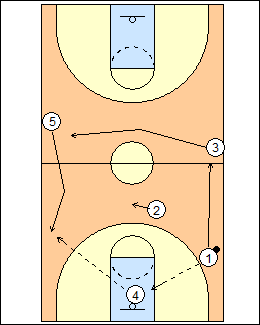Canada Basketball
 | 1 Canada Basketball Level 3 Manual General principles of pressure offence - recognize the press - be aligned to attack it - give the ball to better ballhandlers - a player who is trapped should have three short pass options and one long pass option - come to the ball - score against the press, but control the tempo. A patterned press break can be used against man and zone presses (with a special entry for late-game situations). Use a good passer as the inbounder every time, checking for pressure, clearing the backboard, running the baseline if necessary, and first checking deep for an open player. Balance the court by spacing other players, ballhandling receivers are above the foul line so they can cut towards the ball. See Press breaks - Xavier (2-Up), Hackenberg 2-up. |
 | 2 To get open for the inbounds pass, receivers can - v-cut towards the ball - run at a defender to get even then pop free - screen away and pop open - stack and break to an open area. On catching the ball, pivot and face upcourt. Pass the ball before the defence can trap. Have a player in the middle of the press. Here 1 breaks to the ballside corner (but not the deep corner), on the inbounds pass 2 breaks diagonally across the court. If his defender does not follow the cut, generally the press is a zone. 3 steps inbounds as a reversal option. A pass to 2 creates a 3-on-2 break. If 1 passes ahead to 4, 2 breaks up the middle. Option - against a man press, 4 goes away from the ball and takes a defender up the far sideline, if 1 decides to keep the ball, other teammates clear out. Bill Self - if 4 inbounds to 2 in the lane, 1 cuts middle, 4 goes ballside sideline, 2 is the trailer (5 comes back weakside). 1-2-2 Fullcourt Press Break - the inbounder cuts to the middle on an inbounds pass. |
 | 3 1 has three short passing options and one long option (to 5). Receivers come to the ball if 1 is trapped or has lost his dribble. If 1 can't pass ahead, reverse the ball to 3, 2 cuts to the middle of the court, 5 breaks back as a reversal option. The same approach can be used against a 2-2-1 press. Ball reversal is very important. Dave Odom (Press attack) - 2 stays in the middle, on the line of the ball and the basket. Don Meyer - see the deep diagonal; on a catch in the middle, look opposite. Brian Giorgis - have people you want in the middle handling the ball, and people you don't on the sides passing (some 5s may be nervous with the ball in the middle). Double Middle, Giorgis Regular, LSU Set - 2 cuts up the sideline, 1 replaces 2 in the middle. Bill Self 1-3-1, Duke vs. 1-2-1-1 - 5 goes deep, 2 cuts to the sideline on a pass to 4, 3 cuts middle. Hackenberg 2-up - get into a 2-1-2 set on the inbounds pass, then 5 goes deep, 2 and 3 cut (Zone pressure) or stay in a 2-1-2 with 2 in the middle (Soft pressure, also see Old Dominion Regular). |
 | 4 (Option) 3 mirrors the ball as it is reversed (or if 5 is double-teamed). 1 stretches weakside on a pass to 5. See Don Meyer Press O - 4 Corners - put the best decision-make in the middle. |
 | 5 If 1 is not open for the inbounds pass, he screens away for 2 then rolls back to the ball. If 2 gets the ball in the ballside corner then 1 and 2 have reversed roles. If 1 and 2 can't get open, 3 breaks back to the ball. On an inbounds pass to 3, 1 and 2 cut up the sidelines, 4 flares to the open side as safety. See Old Dominion Regular, Xavier (2-Up), Hackenberg 2-up (Man pressure). (Variation) - 3 flashes back along the sideline, see Double Middle, Hackenberg 2-up (Zone pressure), Bill Self 1-3-1. |
 | 6 (Variation) 1 and 2 get and stay wide after an inbounds pass, creating space in the middle. a) See Hammer and Breaker (Breaker). 1 goes out to get the inbounds pass, 2 goes wide, 3 comes onto the court, 5 flashes middle, 2 releases up the sideline. 2 is ready to come back on ball reversal. |
 | 7 3 can mirror the ball if reversed, and 5 stay in the middle. 1 stretches on a pass to 2, looking for a diagonal pass. See Middle, Michael Lynch, Hoop Tactics. 7th Grade Press Break - 5 goes up the sideline, 3 flashes middle. |
 | 8 b) See Canada Basketball Press Break, also Xavier 2-Up. 3 and 5 start in a tandem, with either at halfcourt. Here 3 is at halfcourt, and will stay in the middle or flash to the ball. 5 will go side to side. If 5 is at halfcourt, X5 may not want to defend a flash to the ball. 5 comes ballside on an inbounds pass to 1 or 2, who are again spaced wide (if the inbounds pass is in the paint, 4 goes wide).  |
This page was made with Basketball playbook from Jes-Soft